Abstract
Bacillus anthracis was agglutinated by several lectins, including those from Griffonia simplicifolia, Glycine max, Abrus precatorius, and Ricinus communis. Some strains of Bacillus cereus var. mycoides (B. mycoides) were strongly reactive with the lectin from Helix pomatia and weakly reactive with the G. max lectin. The differential interactions between Bacillus species and lectins afforded a means of distinguishing B. anthracis from other bacilli. B. cereus strains exhibited heterogeneity with respect to agglutination patterns by lectins but could readily be differentiated from B. anthracis and the related B. mycoides. Spores of B. anthracis and B. mycoides retained lectin receptors, although the heating of spores or vegetative cells at 100 degrees C resulted in a decrease in their ability to be specifically agglutinated. Fluorescein-conjugated lectin of G. max stained vegetative cells of B. anthracis uniformly, suggesting that the distribution of lectin receptors was continuous over the entire cellular surface. B. anthracis cells grown under conditions to promote the production of capsular poly(D-glutamyl peptide) were also readily agglutinated by the lectins, suggesting that the lectin reactive sites penetrate the polypeptide layer. Trypsin, subtilisin, lysozyme, and mutanolysin did not modify the reactivity of B. anthracis with the G. max agglutinin, although the same enzymes markedly diminished the interaction between the lectin and B. mycoides. Because the lectins which interact with B. anthracis are specific for alpha-D-galactose or 2-acetamido-2-deoxy-alpha-D-galactose residues, it is likely that the bacteria possess cell surface polymers which contain these sugars. Lectins may prove useful in the laboratory identification of B. anthracis and possibly other pathogenic Bacillus species, such as B. cereus.
Full text
PDF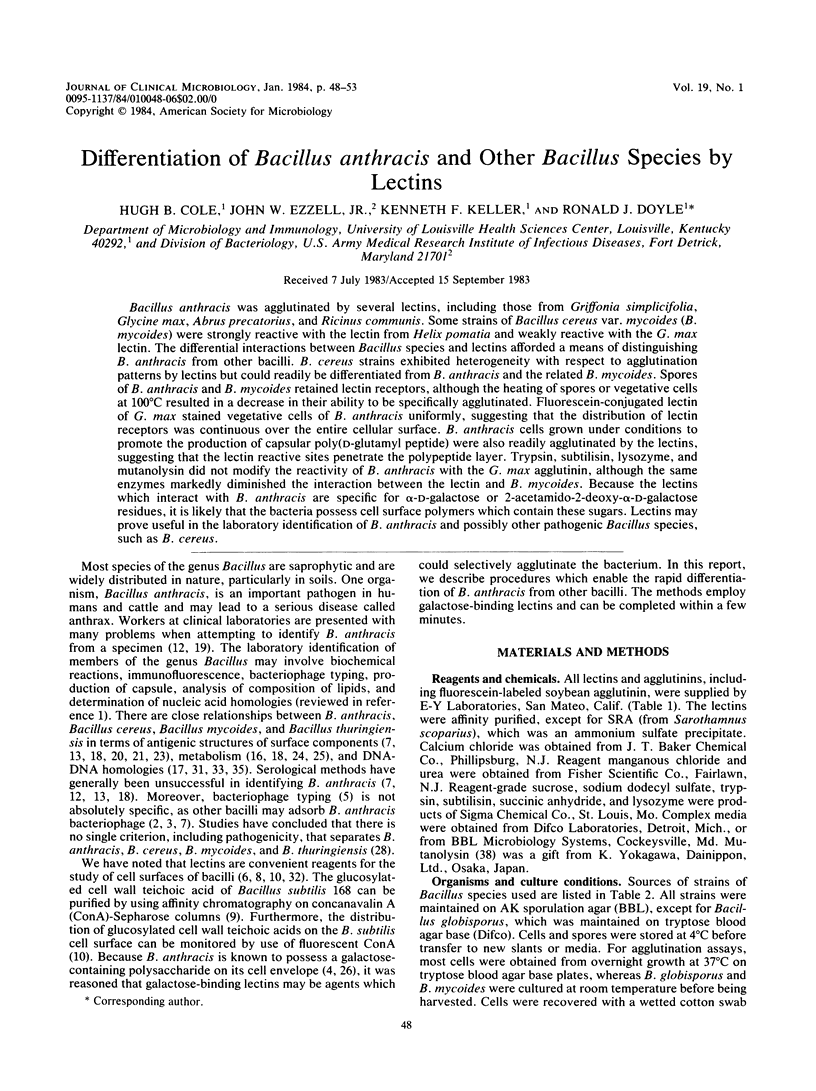
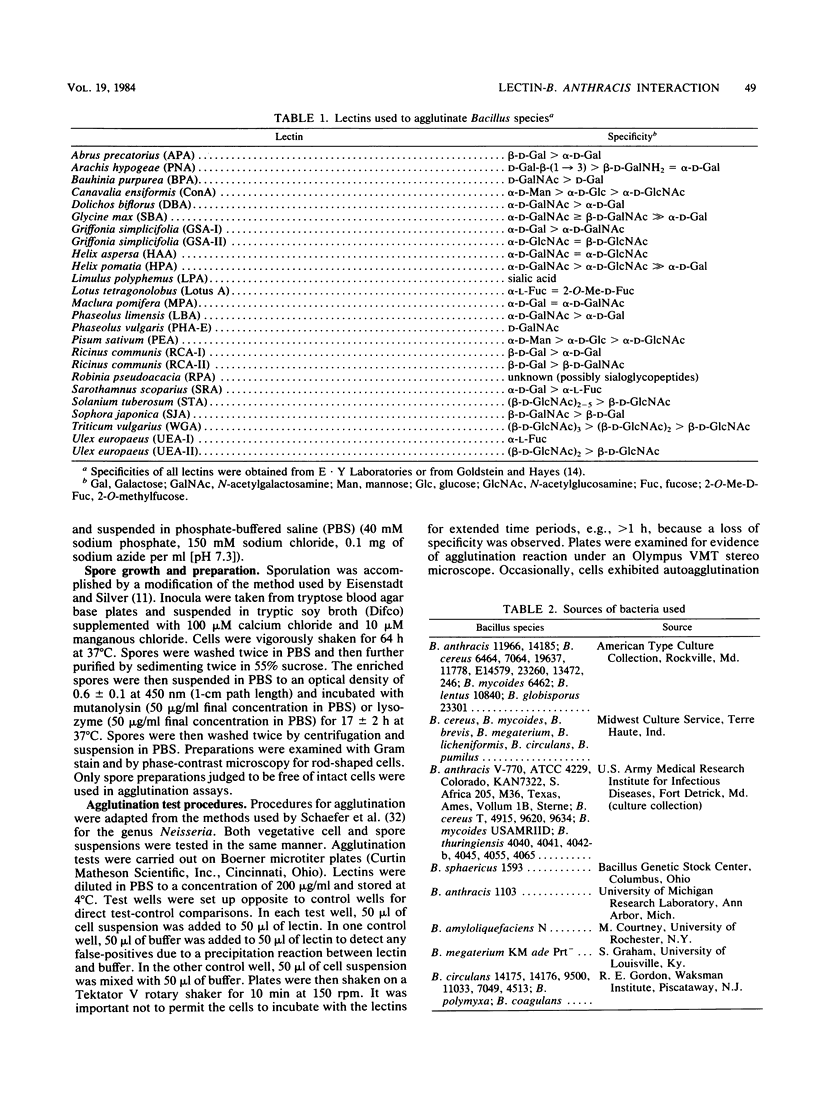
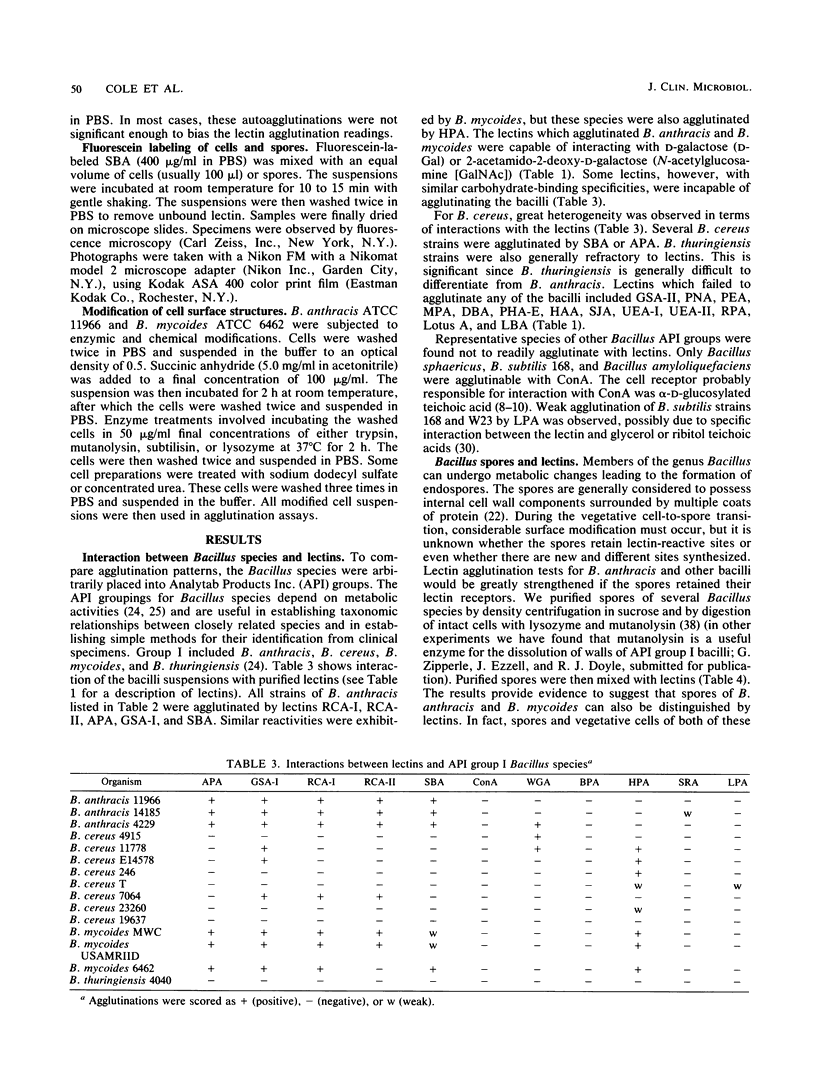
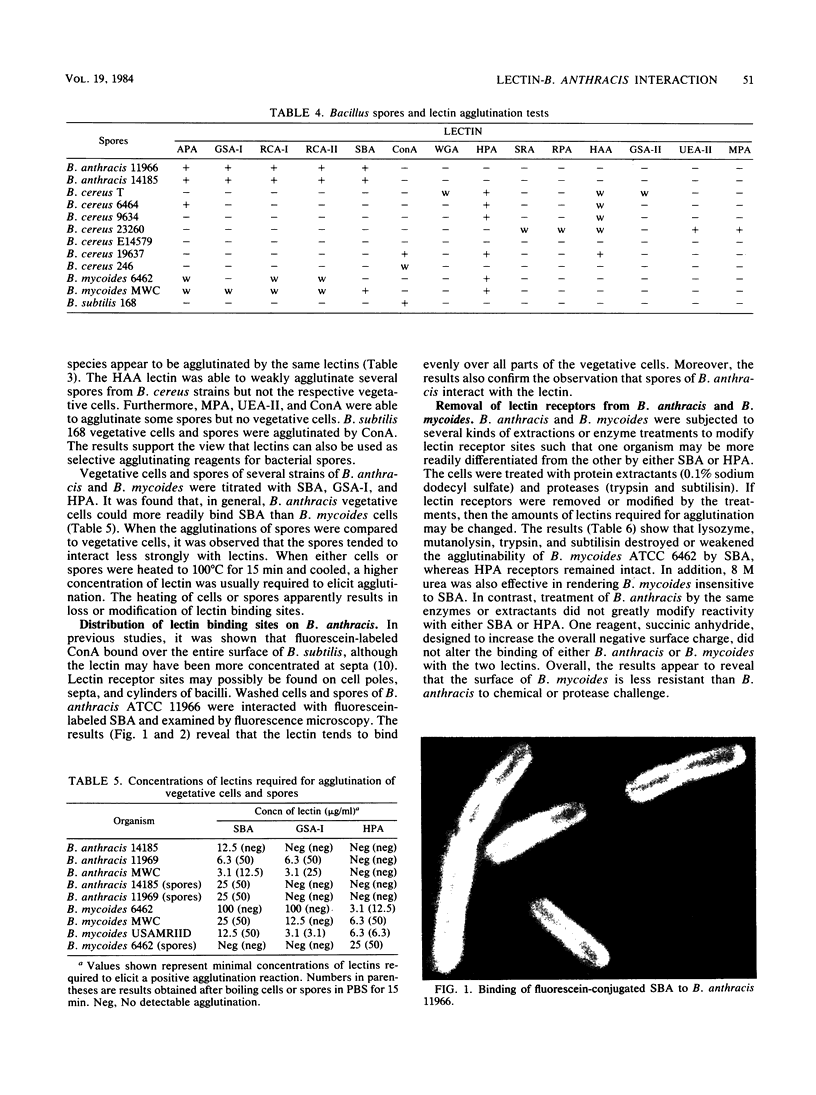
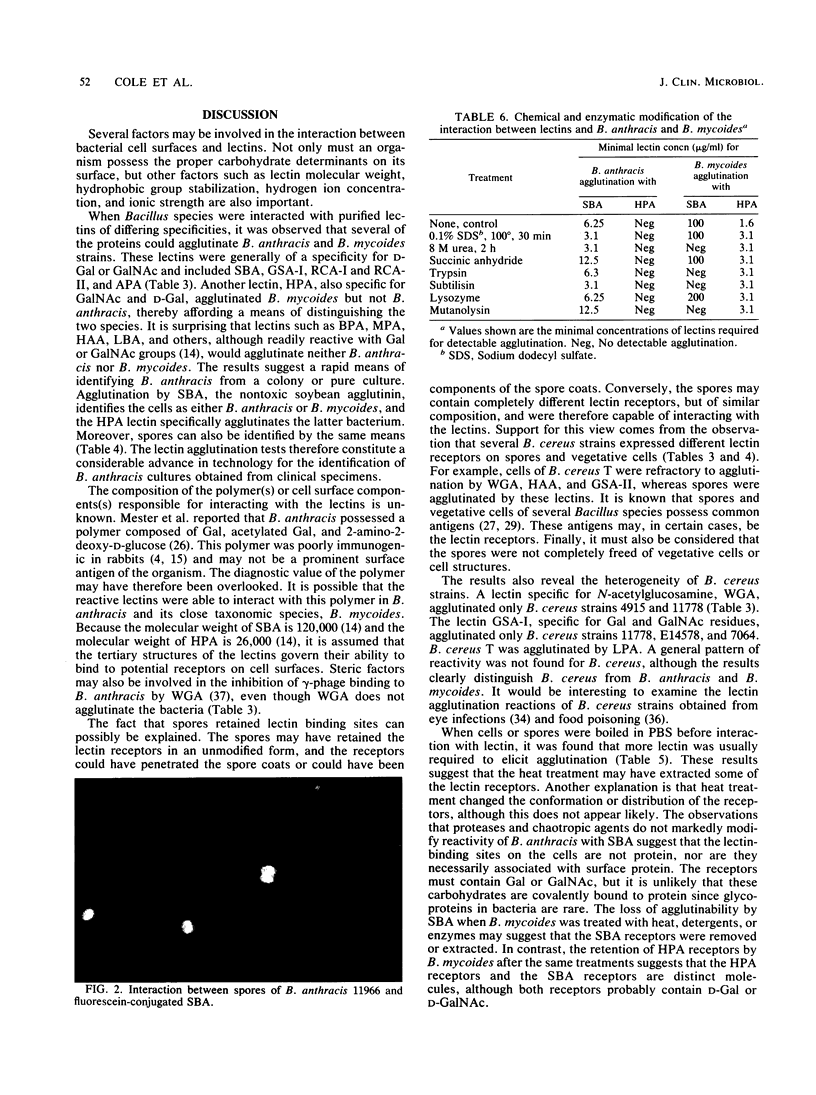
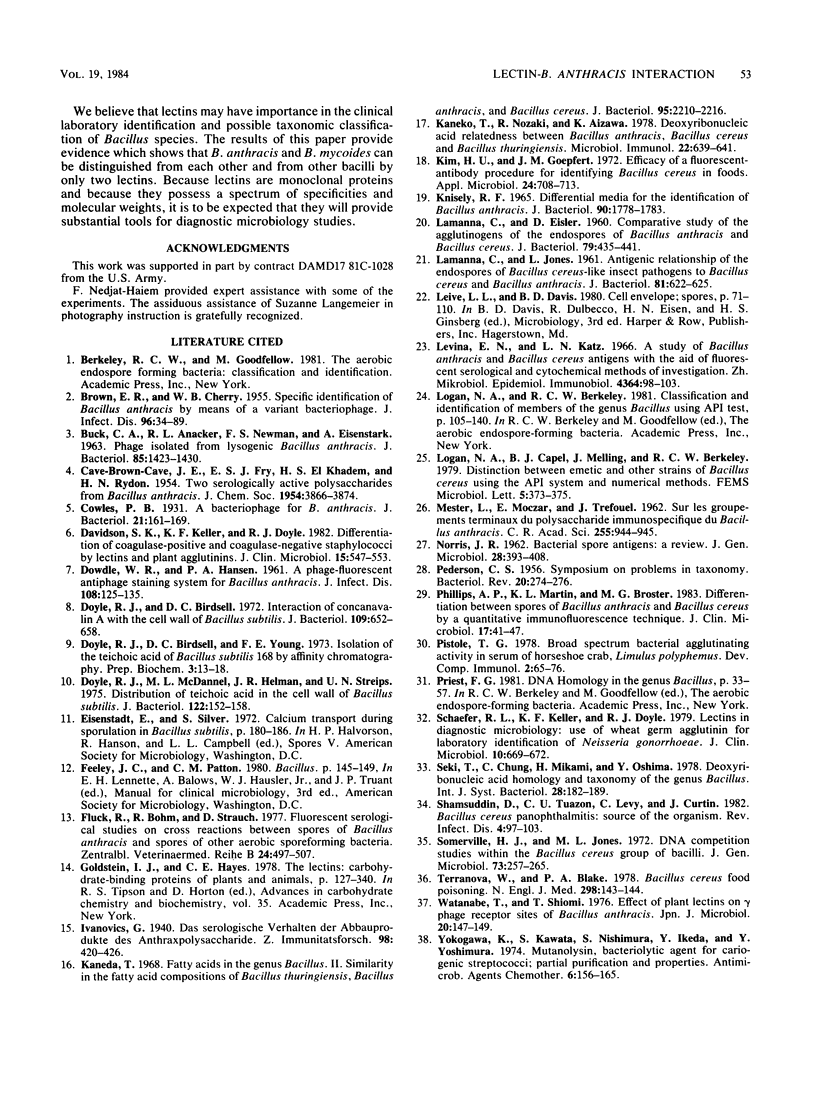
Images in this article
Selected References
These references are in PubMed. This may not be the complete list of references from this article.
- BROWN E. R., CHERRY W. B. Specific identification of Bacillus anthracis by means of a variant bacteriophage. J Infect Dis. 1955 Jan-Feb;96(1):34–39. doi: 10.1093/infdis/96.1.34. [DOI] [PubMed] [Google Scholar]
- BUCK C. A., ANACKER R. L., NEWMAN F. S., EISENSTARK A. PHAGE ISOLATED FROM LYSOGENIC BACILLUS ANTHRACIS. J Bacteriol. 1963 Jun;85:1423–1430. doi: 10.1128/jb.85.6.1423-1430.1963. [DOI] [PMC free article] [PubMed] [Google Scholar]
- Cowles P. B. A Bacteriophage for B. anthracis. J Bacteriol. 1931 Mar;21(3):161–166. doi: 10.1128/jb.21.3.161-166.1931. [DOI] [PMC free article] [PubMed] [Google Scholar]
- DOWDLE W. R., HANSEN P. A. A phage-fluorescent antiphage staining system for Bacillus anthracis. J Infect Dis. 1961 Mar-Apr;108:125–135. doi: 10.1093/infdis/108.2.125. [DOI] [PubMed] [Google Scholar]
- Davidson S. K., Keller K. F., Doyle R. J. Differentiation of coagulase-positive and coagulase-negative staphylococci by lectins and plant agglutinins. J Clin Microbiol. 1982 Apr;15(4):547–553. doi: 10.1128/jcm.15.4.547-553.1982. [DOI] [PMC free article] [PubMed] [Google Scholar]
- Doyle R. J., Birdsell D. C. Interaction of concanavalin A with the cell wall of Bacillus subtilis. J Bacteriol. 1972 Feb;109(2):652–658. doi: 10.1128/jb.109.2.652-658.1972. [DOI] [PMC free article] [PubMed] [Google Scholar]
- Doyle R. J., Birdsell D. C., Young F. E. Isolation of the teichoic acid of Bacillus subtilis 168 by affinity chromatography. Prep Biochem. 1973;3(1):13–18. doi: 10.1080/00327487308061485. [DOI] [PubMed] [Google Scholar]
- Doyle R. J., McDannel M. L., Helman J. R., Streips U. N. Distribution of teichoic acid in the cell wall of Bacillus subtilis. J Bacteriol. 1975 Apr;122(1):152–158. doi: 10.1128/jb.122.1.152-158.1975. [DOI] [PMC free article] [PubMed] [Google Scholar]
- Fluck R., Böhm R., Strauch D. Fluoreszenzserologische Untersuchungen von Kreuzreaktionen swischen Sporen von Bacillus anthracis und Sporen anderer aerober Sporenbildner. Zentralbl Veterinarmed B. 1977 Jun;24(6):497–507. [PubMed] [Google Scholar]
- Goldstein I. J., Hayes C. E. The lectins: carbohydrate-binding proteins of plants and animals. Adv Carbohydr Chem Biochem. 1978;35:127–340. doi: 10.1016/s0065-2318(08)60220-6. [DOI] [PubMed] [Google Scholar]
- Kaneda T. Fatty acids in the genus Bacillus. II. Similarity in the fatty acid compositions of Bacillus thuringiensis, Bacillus anthracis, and Bacillus cereus. J Bacteriol. 1968 Jun;95(6):2210–2216. doi: 10.1128/jb.95.6.2210-2216.1968. [DOI] [PMC free article] [PubMed] [Google Scholar]
- Kaneko T., Nozaki R., Aizawa K. Deoxyribonucleic acid relatedness between Bacillus anthracis, Bacillus cereus and Bacillus thuringiensis. Microbiol Immunol. 1978;22(10):639–641. doi: 10.1111/j.1348-0421.1978.tb00414.x. [DOI] [PubMed] [Google Scholar]
- Kim H. U., Goepfert J. M. Efficacy of a fluorescent-antibody procedure for identifying Bacillus cereus in foods. Appl Microbiol. 1972 Nov;24(5):708–713. doi: 10.1128/am.24.5.708-713.1972. [DOI] [PMC free article] [PubMed] [Google Scholar]
- Knisely R. F. Differential media for the identification of Bacillus anthracis. J Bacteriol. 1965 Dec;90(6):1778–1783. doi: 10.1128/jb.90.6.1778-1783.1965. [DOI] [PMC free article] [PubMed] [Google Scholar]
- LAMANNA C., EISLER D. Comparative study of the agglutinogens of the endospores of Bacillus anthracis and Bacillus cereus. J Bacteriol. 1960 Mar;79:435–441. doi: 10.1128/jb.79.3.435-441.1960. [DOI] [PMC free article] [PubMed] [Google Scholar]
- LAMANNA C., JONES L. Antigenic relationship of the endospores of Bacillus cereus-like insect pathogens to Bacillus cereus and Bacillus anthracis. J Bacteriol. 1961 Apr;81:622–625. doi: 10.1128/jb.81.4.622-625.1961. [DOI] [PMC free article] [PubMed] [Google Scholar]
- Levina E. N., Kats L. N. Izuchenie antigenov V. anthracis i B. cereus s pomoshch'iu liuminestsentno-serologicheskogo i tsitokhimicheskikh metodov issledovaniia. Zh Mikrobiol Epidemiol Immunobiol. 1966 Apr;43(4):98–103. [PubMed] [Google Scholar]
- MESTER L., MOCZAR E., IVANOVICS G. [On the terminal groupings of the immuno-specific polysaccharide of Bacillus anthracis]. C R Hebd Seances Acad Sci. 1962 Jan 29;254:944–945. [PubMed] [Google Scholar]
- NORRIS J. R. Bacterial spore antigens: a review. J Gen Microbiol. 1962 Jul;28:393–408. doi: 10.1099/00221287-28-3-393. [DOI] [PubMed] [Google Scholar]
- Pederson C. S. SYMPOSIUM ON PROBLEMS IN TAXONOMY. Bacteriol Rev. 1956 Dec;20(4):274–278. doi: 10.1128/br.20.4.274-278.1956. [DOI] [PMC free article] [PubMed] [Google Scholar]
- Phillips A. P., Martin K. L., Broster M. G. Differentiation between spores of Bacillus anthracis and Bacillus cereus by a quantitative immunofluorescence technique. J Clin Microbiol. 1983 Jan;17(1):41–47. doi: 10.1128/jcm.17.1.41-47.1983. [DOI] [PMC free article] [PubMed] [Google Scholar]
- Pistole T. G. Broad-spectrum bacterial agglutinating activity in the serum of the Horsehoe crab, Limulus polyphemus. Dev Comp Immunol. 1978 Feb;2(1):65–76. doi: 10.1016/s0145-305x(78)80026-3. [DOI] [PubMed] [Google Scholar]
- Schaefer R. L., Keller K. F., Doyle R. J. Lectins in diagnostic microbiology: use of wheat germ agglutinin for laboratory identification of Neisseria gonorrhoeae. J Clin Microbiol. 1979 Nov;10(5):669–672. doi: 10.1128/jcm.10.5.669-672.1979. [DOI] [PMC free article] [PubMed] [Google Scholar]
- Shamsuddin D., Tuazon C. U., Levy C., Curtin J. Bacillus cereus panophthalmitis: source of the organism. Rev Infect Dis. 1982 Jan-Feb;4(1):97–103. doi: 10.1093/clinids/4.1.97. [DOI] [PubMed] [Google Scholar]
- Somerville H. J., Jones M. L. DNA competition studies within the Bacillus cereus group of bacilli. J Gen Microbiol. 1972 Nov;73(2):257–265. doi: 10.1099/00221287-73-2-257. [DOI] [PubMed] [Google Scholar]
- Terranova W., Blake P. A. Bacillus cereus food poisoning. N Engl J Med. 1978 Jan 19;298(3):143–144. doi: 10.1056/NEJM197801192980306. [DOI] [PubMed] [Google Scholar]
- Watanabe T., Shiomi T. Effect of plant lectins on gamma phage receptor sites of Bacillus anthracis. Jpn J Microbiol. 1976 Apr;20(2):147–149. doi: 10.1111/j.1348-0421.1976.tb00921.x. [DOI] [PubMed] [Google Scholar]
- Yokogawa K., Kawata S., Nishimura S., Ikeda Y., Yoshimura Y. Mutanolysin, bacteriolytic agent for cariogenic Streptococci: partial purification and properties. Antimicrob Agents Chemother. 1974 Aug;6(2):156–165. doi: 10.1128/aac.6.2.156. [DOI] [PMC free article] [PubMed] [Google Scholar]




